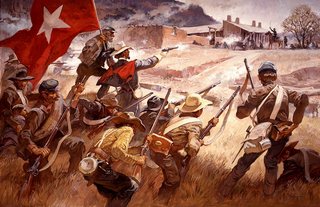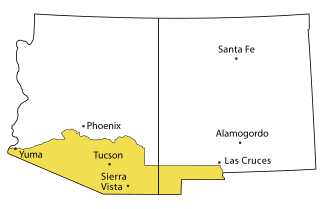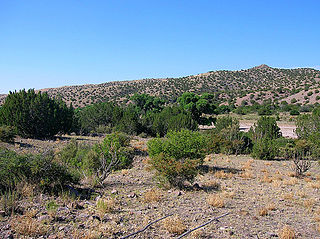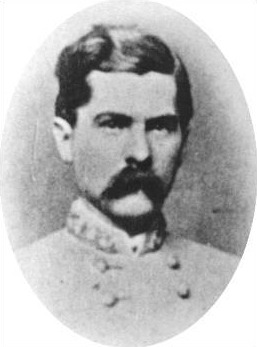History
The army was formed by Brigadier General Henry Hopkins Sibley during the summer of 1861, recruiting from the eastern counties of Texas. [3] Sibley had planned to use local militia companies in forming his regiments, but upon his arrival to Texas he found the militia to be unreliable, so he started recruiting from scratch. [4] Two regiments were formed initially, the 4th and the 5th Mounted Rifles, both with a battery of howitzers attached, but a third regiment, designated the 7th Mounted Rifles, was formed to garrison the territory. [5] The volunteers provided their own weapons, horses, and blankets, with minimal supplies given from the government warehouses. As a result, the weapons used by the troops varied widely, including rifle muskets, squirrel guns, and double barreled shotguns. [6] After initial training in San Antonio, the regiments were sent by detachments to Fort Bliss near El Paso in October, where Sibley formally took command of the military units in the Confederate Arizona Territory. Once the command was concentrated at Fort Bliss, Sibley then sent them to Fort Thorn in New Mexico, where it remained for a month. [7]
The army began operations in the territory in mid-February 1862, when it moved north against the Union garrison at Fort Craig. Arriving at the fort on February 13, Sibley first attempted to lure the Federals out into the open; when this plan failed, he then tried moving north of the fort to cut its supply lines. [8] The Union commander, Colonel E.R.S. Canby, reacted by following Sibly north and attacking him at Valverde Ford. At this time, Sibley was either suffering from kidney disease or was drunk; early in the battle he was forced to turn command over to Colonel Thomas Green of the 5th Texas. The battle developed into a stalemate, which continued until late afternoon when the Union left counterattacked following a Confederate attack. This created a gap between the Union left and center; Green ordered a charge into the gap, driving the Union force back across the Rio Grande and capturing four cannons. [9] Although he lost the Battle of Valverde, Canby refused to surrender as Sibley had expected, and Sibley felt that the fort was too strong to attack. Consequently, he decided to continue northward, crossing the border into New Mexico Territory and leaving Canby in his rear. [10] Due to the number of horses lost at the battle, the 4th Texas had to be dismounted and a number of supply wagons were abandoned and burned. [11]
Forage, there was none; commissary supplies were getting scarce; the cold season was coming; clothing was being needed; all of which the country afforded none." Theophilus Noel.
Rosenberg, p. 53.
Sibley continued northward, capturing Albuquerque on March 2 and Santa Fe on March 13 but failed to capture the Union supplies there. This forced the Confederates to live off the land, but were only able to find a fraction of the supplies they needed; in addition, the foraging alienated the local population. [6] After establishing his headquarters at Albuquerque, Sibley sent an advance force under the command Major Charles Pyron to Apache Canyon to watch for Union movements from the north along the Santa Fe Trail. A second detachment moved to the south to keep watch on Canby's force, while the main body under Lieutenant Colonel William R. Scurry moved slowly northward to unite with Pyron. [12] A Union column from Fort Union under the command of Col. John P. Slough was moving south at this time. An advance guard from this column collided with Pyron's force on March 26, with the Confederates being driven back through the pass. That evening, in response to a message from Pyron, Scurry arrived with the main force and spent the next day observing the Union force, expecting an attack. [13] At the Battle of Glorieta Pass on March 28, the main Confederate force under Scurry fought a Union force marching from Fort Union, driving it back through the pass. However, a Union detachment was able to march around the Confederates and burned its wagon train, destroying most of the Confederate army's supplies.
After learning of the Union victory, Canby advanced northward in order to unite with the northern force and surround Sibley. Nearly out of ammunition and food, Sibley retreated back to Albuquerque with less than 2,000 men on April 8, a few hours after Canby arrived. Following the arrival of the force from Fort Union, Sibley decided to continue the retreat due to a shortage of rations, ammunition, and forage. [14] The only battle to take place during the retreat was a small battle at Peralta on April 15, when Canby attempted to capture a portion of the Confederate army. After the Confederates took up positions in the adobe houses and ditches surrounding the town, Canby decided that the positions were too strong for an assault, so he tried to cut off the Confederates' retreat. During this movement, Sibley arrived with the 5th and 7th Texas regiments and managed to stop Canby's attack. Both sides bombarded each other with artillery until a sandstorm blew in, during which the Confederates withdrew from the field. [15] The Confederates were forced to abandon eight howitzers and leave dozens of wounded behind during their retreat. [16] A small rear was left to guard at Fort Thorn in New Mexico, but this also had to retreat in early July, due to advancing Union forces from California. During the campaign, the army lost approximately a thousand men, nearly half of which were missing or captured. [17]
The army was sent eastward to Louisiana, where it fought in several skirmishes and battles, including the Red River Campaign. Sibley was relieved of command of the brigade due to drunkenness and reassigned to directing supply trains. [18] The cannons captured at Valverde were formed into an artillery unit manned by volunteers from the 5th Texas, designated the Valverde Battery. [19]

The Battle of Glorieta Pass was fought March 26–28, 1862 in the northern New Mexico Territory, by Union and Confederate forces during the American Civil War. While not the largest battle of the New Mexico campaign, the Battle of Glorieta Pass ended the Confederacy's efforts to capture the territory and other parts of the western United States.
The following is a list of engagements that took place in 1862 during the American Civil War. During the summer and early spring of the year, Union forces gained several successes over the Confederacy, seizing control of Missouri, northern Arkansas, Kentucky, and western Tennessee, along with several coastal areas. Confederate forces defended the capital of Richmond, Virginia, from Union assaults, and then launched counter–offensives into Kentucky and Maryland, both of which end in Union victories.

The New Mexico campaign was a military operation of the trans-Mississippi theater of the American Civil War from February to April 1862 in which Confederate Brigadier General Henry Hopkins Sibley invaded the northern New Mexico Territory in an attempt to gain control of the Southwest, including the gold fields of Colorado and the ports of California. Historians regard this campaign as the most ambitious Confederate attempt to establish control of the American West and to open an additional theater in the war. It was an important campaign in the war's Trans-Mississippi Theater, and one of the major events in the history of the New Mexico Territory in the American Civil War.

The Battle of Valverde, also known as the Battle of Valverde Ford, was fought from February 20 to 21, 1862, near the town of Val Verde at a ford of the Rio Grande in Union-held New Mexico Territory, in what is today the state of New Mexico. It is considered a major Confederate success in the New Mexico Campaign of the American Civil War, despite the invading force abandoning the field. The belligerents were Confederate cavalry from Texas and several companies of Arizona militia versus U.S. Army regulars and Union volunteers from northern New Mexico Territory and the Colorado Territory.

The First Battle of Mesilla was fought on July 25, 1861, at Mesilla in New Mexico Territory, in present-day Doña Ana County, New Mexico.

John Potts Slough was an American general and politician who led Union forces at the Battle of Glorieta Pass during the American Civil War. After the war, he was appointed chief justice of the New Mexico Territorial Supreme Court, serving until his assassination in 1867.
The Army of Western Louisiana was a part of the Confederate States Army during the American Civil War. It fought in all the major engagements during Union Maj. Gen. Nathaniel P. Banks' campaign to capture Port Hudson, Louisiana. For much of its existence, it served under Maj. Gen. Richard Taylor. Perhaps its crowning achievement was its victory in April 1864 at the Battle of Mansfield.

The New Mexico Territory, comprising what are today the U.S. states of New Mexico and Arizona, as well as the southern portion of Nevada, played a small but significant role in the trans-Mississippi theater of the American Civil War. Despite its remoteness from the major battlefields of the east, and its being part of the sparsely populated and largely undeveloped American frontier, both Confederate and Union governments claimed ownership over the territory, and several important battles and military operations took place in the region. Roughly 7,000-8,000 troops from the New Mexico Territory served the Union, more than any other western state or territory.

Fort Craig was a U.S. Army fort located along El Camino Real de Tierra Adentro, near Elephant Butte Lake State Park and the Rio Grande in Socorro County, New Mexico.

Charles Lynn Pyron (1819–1869) was a soldier in the United States Army in the Mexican–American War and a Confederate Army officer in the American Civil War. He fought at the Battle of Monterrey in the Mexican–American War, and during the Civil War fought in the West, including at the battles of Valverde and Glorieta Pass.

Prior to the adoption of its name for a U.S. state, Arizona was traditionally defined as the region south of the Gila River to the present-day Mexican border, and between the Colorado River and the Rio Grande. It encompasses present-day Southern Arizona and the New Mexico Bootheel plus adjacent parts of Southwestern New Mexico. This area was transferred from Mexico to the United States in the Gadsden Purchase of 1853. Mining and ranching were the primary occupations of traditional Arizona's inhabitants, though growing citrus fruits had long been occurring in Tucson.

The Battle of Canada Alamosa as it was known to the Union Army, or Alamosa as it was known to the Confederates, was a skirmish of the American Civil War on the late evening of September 24 and the morning of September 25, 1861. It was one of several small battles that occurred in Confederate Arizona near the border with Union held New Mexico Territory, this one being the largest.
The Company A, Arizona Rangers was a cavalry formation of the Confederate States Army during the American Civil War.
The Department of New Mexico was a department of the United States Army during the mid-19th century. It was created as the 9th Department, a geographical department, in 1848 following the successful conclusion of the Mexican–American War, and renamed Department of New Mexico in 1853. It had to contend with an invading Confederate force during the New Mexico Campaign of the American Civil War from mid-1861 to early 1862, then with Apache tribes during the remainder of the conflict. It was merged into the Department of California after the end of the war as the District of New Mexico.
Hispanics in the American Civil War fought on both the Union and Confederate sides of the conflict. Not all the Hispanics who fought in the American Civil War were "Hispanic Americans" — in other words citizens of the United States. Many of them were Spanish subjects or nationals from countries in the Caribbean, Central and South America. Some were born in what later became a U.S. territory and therefore did not have the right to U.S. citizenship. It is estimated that approximately 3,500 Hispanics, mostly Mexican-Americans, Puerto Ricans and Cubans living in the United States joined the war: 2,500 for the Confederacy and 1,000 for the Union. This number increased to 10,000 by the end of the war.

Union forces entered Tucson on May 20, 1862, with a force of 2,000 men without firing a shot.
Sherod Hunter was the commander of the Confederate unit operating against Union Army forces in present-day Arizona during the American Civil War. He later commanded various Confederate cavalry units elsewhere in the Trans-Mississippi Theater.

William Polk Hardeman was a Confederate States Army brigadier general during the American Civil War. He had fought in the Texas War of Independence in 1836. He was a member of the Texas Rangers and fought in the Mexican-American War in 1846–1847. During the Civil War, he participated in Brigadier General Henry Hopkins Sibley's New Mexico Campaign and in the Red River Campaign. He had a variety of occupations after the war, including superintendent of public buildings and grounds at Austin, Texas.
Alexander McRae was a U.S. Army officer from North Carolina, who served on the antebellum frontiers in Texas and New Mexico, and fought in the Union Army, being killed in the Battle of Valverde.
The Skirmish near Fort Thorn, New Mexico Territory, also known as the Fight at E Company Grove, was a skirmish of the American Civil War on the morning of September 26, 1861. It followed the Battle of Canada Alamosa one of several small battles that occurred near the border between Confederate Arizona and Union New Mexico Territory. This one being an attempt by detachments of three companies of the Union Regiment of Mounted Rifles to pursue the Confederate cavalry force of Captain Bethel Coopwood's San Elizario Spy Company, and detachments of Company B and E, Second Texas Mounted Rifles, that was retiring from their victory at Canada Alamosa toward their base at Camp Robledo, 12 mi (19 km) north of Doña Ana, New Mexico.











